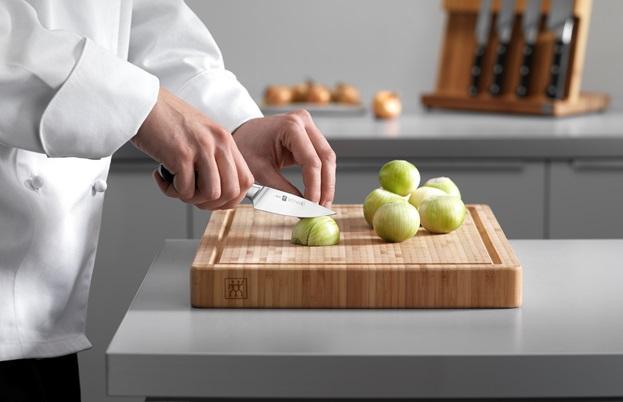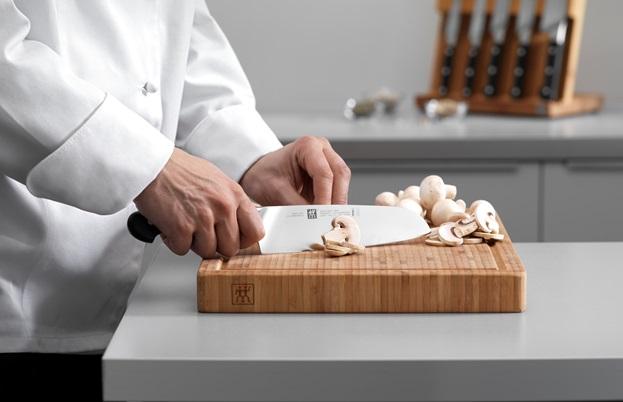A complete guide to knives
Ever wondered why chefs have an arsenal of knives at their disposal, rather than just one or two? Our ultimate guide explains the characteristics of each one, from paring to santoku, and what you should look out for when choosing your own set
Ask any chef what they’d save if their house was on fire, and most would brave the flames to save their precious knives. By far the most important tool any cook can have in the kitchen, a sharp knife makes food a joy to prep, is much safer to use than a dull blade and allows for more accurate and detailed slicing, chopping, prepping and dicing.
While owning one good quality all-round knife (usually a cook’s or chef’s knife) is much better than having several dull or poor quality knives at your disposal, a full set really opens up your options when it comes to cooking at home. If you like the idea of filleting fish, dabbling in a little butchery or carving a leg of lamb like a pro, then you need the tools for the job. Read on to discover the differences between some of the most common knife types in the average chef’s set, what to look out for when buying knives and how to care for them once you’ve got them home.
The knives
Paring knife: one of the smallest knives available, a paring knife is used to prepare small vegetables and fruit such as chopping or peeling. Its small size means it is easier to tackle delicate or detailed tasks, such as deseeding small chillies, and its sharp tip is used to remove blemishes.

Cook’s or chef’s knife: Arguably the most important knife of all, this is a true workhorse and can be used for all manner of tasks. The blades can differ in length but will always be large enough to prepare meat, larger fruits and vegetables and finely chop everything from herbs to onions.
Bread knife: The serrated blade of a bread knife means it will saw through breads both soft and hard without affecting the texture. It has a very long blade and is also very useful for slicing or serving cakes and other baked goods.
Santoku knife: This Japanese knife is very versatile and can be used for all sorts of prep. The small indentations next to the blade’s edge allows food to slide off the metal easily, and the blunt, rounded end helps balance the knife and means it can be used more like a cleaver.
Chinese chef’s knife: European chefs have a variety of blades to choose from, but in China many cooks rely on just one in the kitchen. Shaped like a cleaver, it is used to slice and chop through all foods (although it is not strong enough to cut through bone, despite its appearance). The large rectangular blade means it’s quite heavy, which helps cut through more substantial ingredients with minimal effort.
Boning knife: The thin blade of a boning knife is specially designed to remove meat from bones with as little waste as possible. It’s rigid and strong enough to cut through connective tissue but small enough to easily work its way around joints and fiddly bones.
Filleting knife: With a bendy, flexible blade, filleting knives are made for preparing whole fish. Used on its side, the knife will follow the backbone of both round and flat fish with ease, creating perfect fillets with minimal waste.
Carving knife: A very long, sharp knife with a particularly sharp point that’s perfect for carving whole joints and other meats. Most have a plain edge but some are serrated to help saw through the meat.
Paring knife: Paring knives are ideal for preparing small fruits and vegetables.
Santoku: The rounded tip of a santoku knife helps to balance the blade in the hand.
How to hold a knife
Regardless of the type of knife you are using the method of holding a knife is the same. It is known as a “pinch grip” and is the safest, most efficient and most effective way to use a knife.

To hold the knife, grip it by placing your thumb and forefinger around the base of the blade in a pinching position. Wrap the other 3 fingers around the handle of the knife.
To cut, centre the knife in the middle of the chopping board and begin to create a rocking motion, up and over, using the whole length of the knife.
Use your other hand to make a claw shape – you will use this as a guide for your knife.
Place the claw over the food you wish to cut, being sure to keep your fingertips tucked underneath away from the blade.
When cutting the food, rather than pushing it toward the knife, run you fingers over it, using your thumb for support.
Sit the knife alongside your fingers and begin to slice all the way through the food, using the whole length of the knife.
Buying a knife set
Zwilling J A Henckels’ own chef Paul Bough knows everything there is to know about knives. Before you head to the shops to pick up a new set, read his top tips for buying the very best.
“Go for a knife manufactured with high quality steel. The quality and hardness of the steel will dictate how long the sharpness of the cutting edge will last and how easily the knife can be maintained and sharpened.
“Manufacturing and construction is key. Look for a knife that’s fully precision-forged from one piece of steel and a blade that’s been thermally treated. Fully forging a knife gives it strength, plus the weight of the bolster will help with balance and stability, which in turn improves comfort and ease of use during cutting. The right thermal treatment, including ice-hardening, will enhance the steel’s durability, material flexibility and corrosion resistance, meaning your knife will last longer and perform better.
“A good knife needs to be comfortable during prolonged use, so use a knife where any joins between the materials are seamless. This will prevent calluses forming on the hand as there will be no rough or pronounced edges rubbing against the skin. A good knife will have been designed with ergonomics in mind.
“Make sure the range is right for you. Although an all-purpose knife like the chef’s knife is versatile, you may also want specialist knife shapes for certain jobs. Although they’re a similar shape, you wouldn’t use a Chinese chef’s knife as a cleaver to chop through bone and you’d be well advised not to use a slim, flexible filleting knife on hard root vegetables.
“All the above elements add up to one thing: sharpness. A sharp knife is a safe knife as it requires less pressure to cut and is less likely to slip while slicing.”
Care and maintenance
Once you’ve picked out the right knives for your needs, knowing how to look after them will ensure they stay razor-sharp and safe to use. By following just a few simple rules, you can keep them in prime condition – as Paul explains.
“Cleaning and storing your knives in the right way is really important for their proper care and your safety,” he says. “Good knives shouldn’t be exposed to the harsh environment of a dishwasher, where high humidity and aggressive detergents will attack even the highest quality steel; cleaning with warm running water, a little washing-up liquid and a soft cloth or sponge will suffice, and always rinse and dry immediately.”
Keep in mind that there are four different ways to store knives too – chefs will use a roll or case to easily transport their blades, but at home a knife block, magnetic rack or drawer are more common. “If you’re going to keep knives in a drawer, it’s worth investing in sheathes to cover the blades,” explains Paul. “Not only will this prevent the danger of cuts if you reach in without looking, but it will also protect the blade from clashing against other tools in the drawer which could chip or dull the cutting edge.
“Use a bamboo or plastic cutting board which is kind to the edge, not a glass or granite board which will prematurely dull your blade. Maintain your knife with a set of diamond and honing steels, whetstones or a pull through sharpener. This care, coupled with high quality design, manufacturing and materials will give you a sharp knife that will be a companion in the kitchen for years to come.”
Video and guide from Great British Chefs. Visit their site for more kitchen knife skills
Join our commenting forum
Join thought-provoking conversations, follow other Independent readers and see their replies
Comments
Bookmark popover
Removed from bookmarks